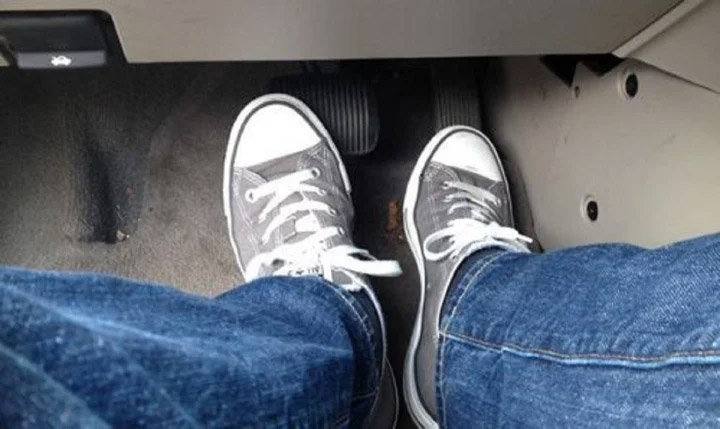Car manufacturers always recommend that automatic drivers should only use their right foot for the gas pedal and brake pedal, while the left foot rests. However, many drivers have the habit of using their left foot for the brake pedal and their right foot for the gas pedal. This is a very dangerous habit that carries a high risk of serious traffic accidents, so it needs to be eliminated immediately.
There are two main reasons why manufacturers and experts advise drivers not to use both feet when driving an automatic car and to only use their right foot:
The first reason is the design of the car: In automatic cars, the gas pedal and the brake pedal are designed offset to the right. Therefore, if the driver uses their left foot, it is the incorrect posture and can result in twisting the body and misaligning the spine while driving.

Many people have the habit of using their left foot for the brake pedal and their right foot for the gas pedal in automatic cars. (Illustrative image).
The second reason is in terms of operation: Using both feet when driving an automatic car can easily lead to simultaneously depressing both the gas and brake pedals while moving on the road. This habit of drivers causes the brakes to work continuously, leading to overheating and loss of effectiveness. In addition, this also causes a decrease in the car’s performance and an increase in fuel consumption.
More importantly, if both feet are used when driving an automatic car, in unexpected situations, reflexively, the driver will depress both feet, reducing the ability to stop the car and significantly increasing the risk of accidents.
What are the cases that are prone to accidentally depressing the gas pedal?
One of the most common cases that lead to accidentally depressing the gas pedal is when the driver encounters unexpected situations in a confined space. For example, when the driver is trying to accelerate quickly to overtake another car but the space is limited due to oncoming traffic, a median barrier on the left or right side.
In addition, other cases that are prone to mistakenly pressing the gas pedal instead of the brake pedal are when the driver is driving on a narrow road, driving slowly, not putting any load on the engine, or reversing the car into a parking space. These are all situations that easily lead to accidentally depressing the gas pedal when driving an automatic car.
How to avoid accidentally depressing the gas pedal?
To avoid accidentally depressing the gas pedal when driving an automatic car, there are two decisive conditions that need to be followed: Keeping the mind always alert and practicing the habit of “the right foot never rests”.
Specifically, once seated behind the steering wheel, the driver needs to ensure their health is in the best condition, without fatigue, pain in the limbs, hands, shoulders, or back. In particular, absolutely do not consume alcohol, beer, or stimulants that excessively stimulate the nerves.
The next condition is to train the mechanism of using the foot flexibly, not allowing the right foot to stay on the brake pedal or gas pedal for too long. Changing the position of the foot will help avoid numbness and help the brain make more accurate decisions. For example, when driving for a long time on a highway, instead of keeping the foot on the gas pedal, drivers should occasionally remove their foot, rotate the ankle back and forth to have a sense of the foot.
Driving principles
Foot always on the floor
Keep the foot on the floor and only use the brake pedal to control the gas and brake. The heel should be positioned in line with the brake pedal, using the ball of the foot to move back and forth. This is a way to avoid confusion and allow for adjustment of the gas and brake force while driving.
Lift off the gas pedal – Hover over the brake pedal
Training the habit of lifting off the gas pedal and hovering over the brake pedal will help the driver always in a ready position to brake instead of pressing the gas pedal.
Regarding the foot placement skill while driving, experts say that placing the foot in a V shape will provide the most comfortable and safe operation. However, it should be noted in cases of sudden braking. Some drivers have the habit of rotating their ankle to press the brake pedal, but this gesture can be dangerous in cases where the brake and gas pedals are level and close together. At that time, most of the foot is on the brake but still partly on the gas, causing the brake to lose effectiveness.
To overcome this situation with cars that have brake and gas pedals at the same level and close together, it is necessary to practice the habit of lifting the foot completely and pressing it firmly every time there is sudden braking. The geometric arrangement between the driver’s seat and the gas pedal helps the driver always press on the brake if the right foot is pressing straight and firmly.
The last and not least important point when driving an automatic car is always to comply with the speed limit. The maximum speed allowed is calculated based on many factors, ensuring sufficient space and terrain for the driver to react quickly and accurately in case of an incident.
According to VTC News.
































